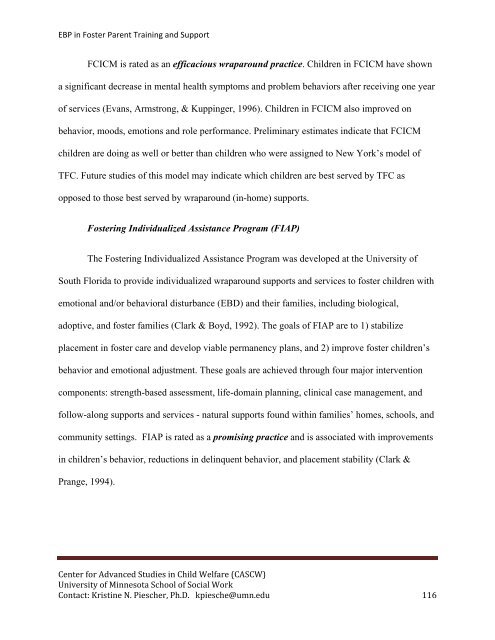Evidence-Based Practice in Foster Parent Training and Support ...
Evidence-Based Practice in Foster Parent Training and Support ...
Evidence-Based Practice in Foster Parent Training and Support ...
You also want an ePaper? Increase the reach of your titles
YUMPU automatically turns print PDFs into web optimized ePapers that Google loves.
EBP <strong>in</strong> <strong>Foster</strong> <strong>Parent</strong> Tra<strong>in</strong><strong>in</strong>g <strong>and</strong> <strong>Support</strong>FCICM is rated as an efficacious wraparound practice. Children <strong>in</strong> FCICM have showna significant decrease <strong>in</strong> mental health symptoms <strong>and</strong> problem behaviors after receiv<strong>in</strong>g one yearof services (Evans, Armstrong, & Kupp<strong>in</strong>ger, 1996). Children <strong>in</strong> FCICM also improved onbehavior, moods, emotions <strong>and</strong> role performance. Prelim<strong>in</strong>ary estimates <strong>in</strong>dicate that FCICMchildren are do<strong>in</strong>g as well or better than children who were assigned to New York’s model ofTFC. Future studies of this model may <strong>in</strong>dicate which children are best served by TFC asopposed to those best served by wraparound (<strong>in</strong>-home) supports.<strong>Foster</strong><strong>in</strong>g Individualized Assistance Program (FIAP)The <strong>Foster</strong><strong>in</strong>g Individualized Assistance Program was developed at the University ofSouth Florida to provide <strong>in</strong>dividualized wraparound supports <strong>and</strong> services to foster children withemotional <strong>and</strong>/or behavioral disturbance (EBD) <strong>and</strong> their families, <strong>in</strong>clud<strong>in</strong>g biological,adoptive, <strong>and</strong> foster families (Clark & Boyd, 1992). The goals of FIAP are to 1) stabilizeplacement <strong>in</strong> foster care <strong>and</strong> develop viable permanency plans, <strong>and</strong> 2) improve foster children’sbehavior <strong>and</strong> emotional adjustment. These goals are achieved through four major <strong>in</strong>terventioncomponents: strength-based assessment, life-doma<strong>in</strong> plann<strong>in</strong>g, cl<strong>in</strong>ical case management, <strong>and</strong>follow-along supports <strong>and</strong> services - natural supports found with<strong>in</strong> families’ homes, schools, <strong>and</strong>community sett<strong>in</strong>gs. FIAP is rated as a promis<strong>in</strong>g practice <strong>and</strong> is associated with improvements<strong>in</strong> children’s behavior, reductions <strong>in</strong> del<strong>in</strong>quent behavior, <strong>and</strong> placement stability (Clark &Prange, 1994).Center for Advanced Studies <strong>in</strong> Child Welfare (CASCW)University of M<strong>in</strong>nesota School of Social WorkContact: Krist<strong>in</strong>e N. Piescher, Ph.D. kpiesche@umn.edu 116
















